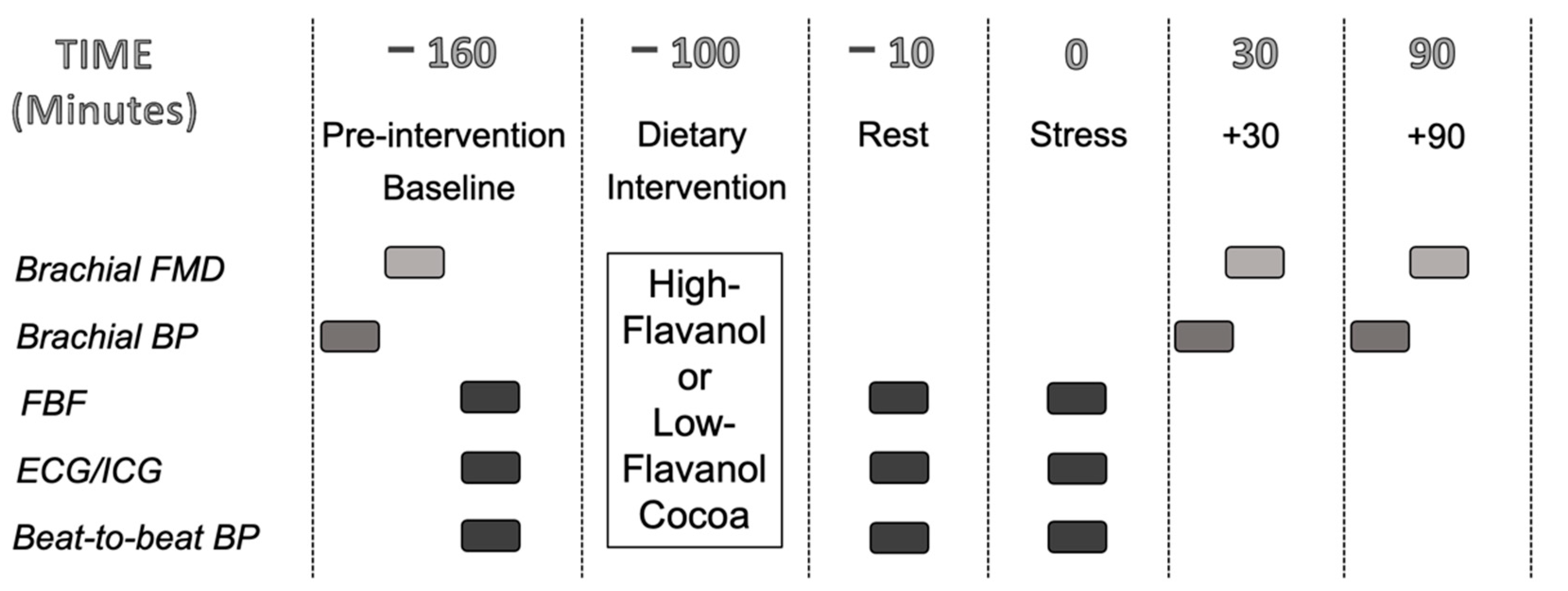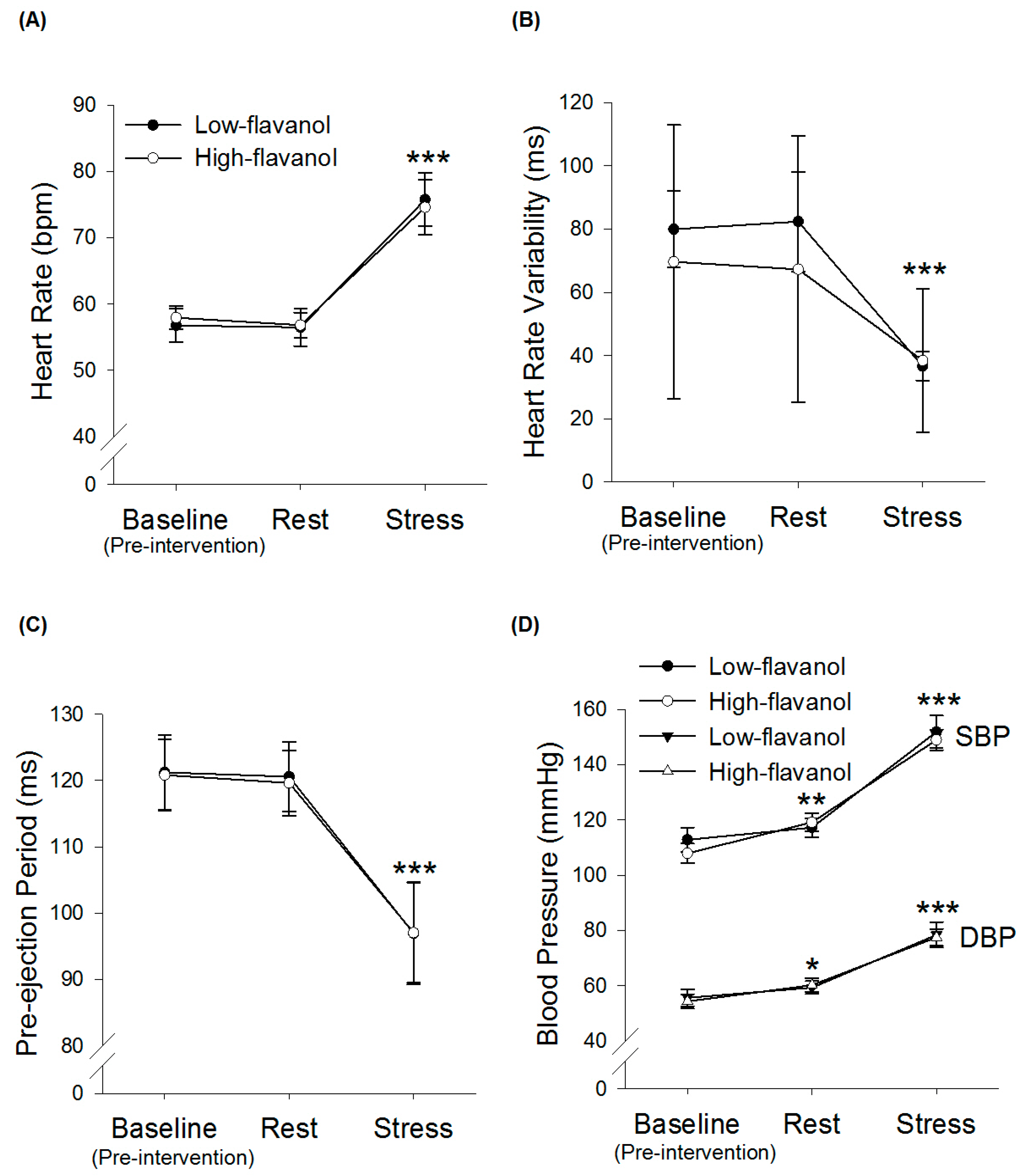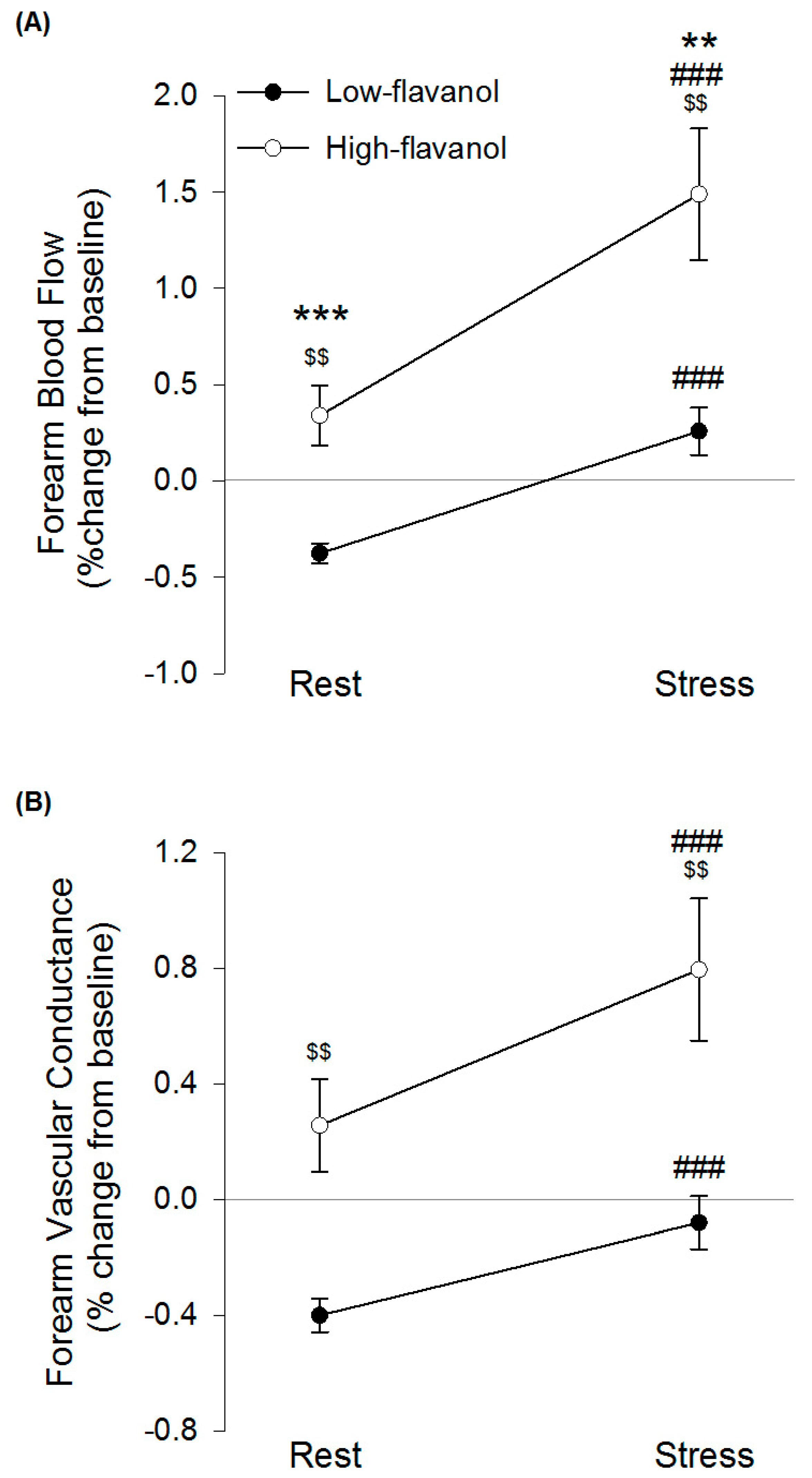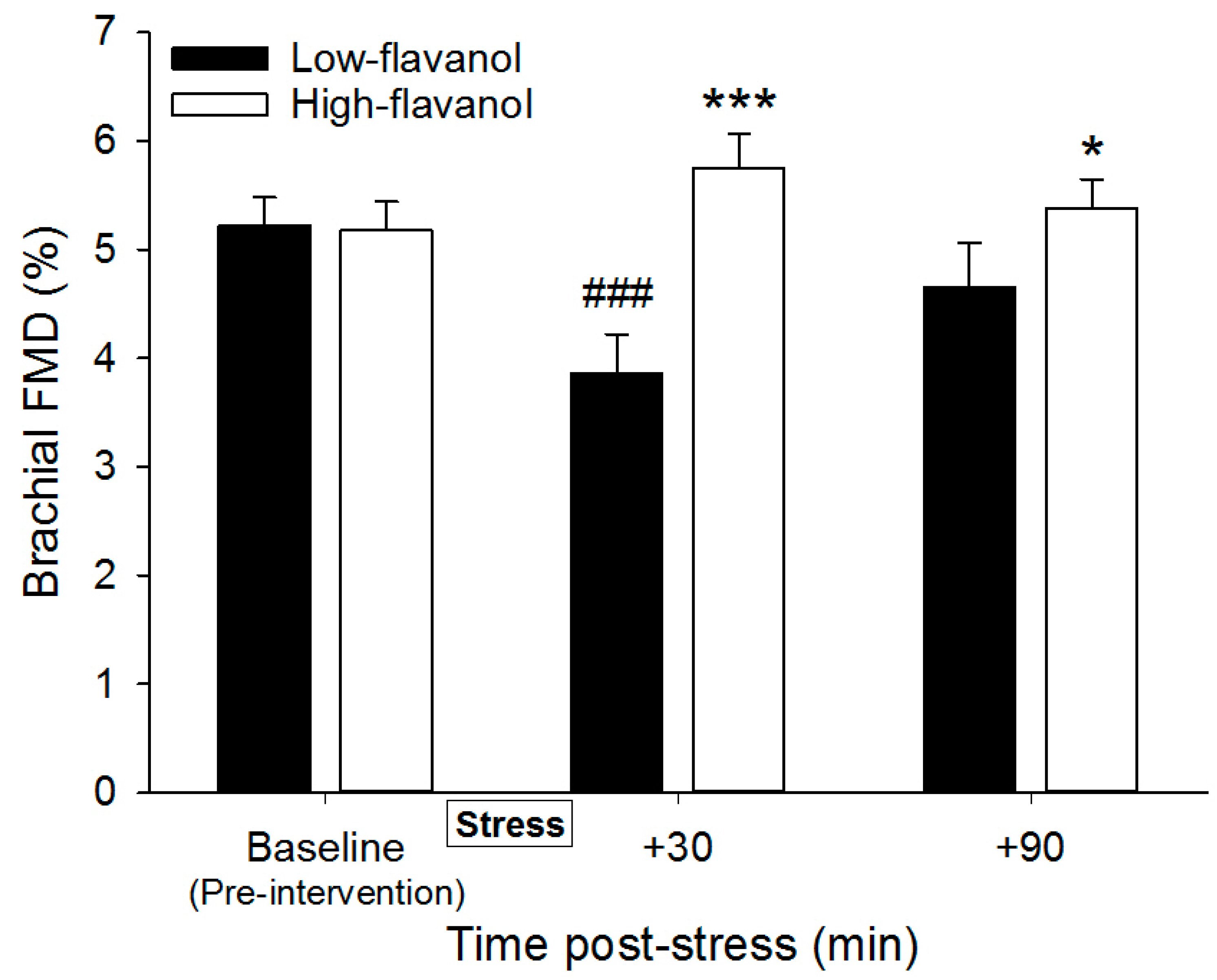Cocoa Flavanols Improve Vascular Responses to Acute Mental Stress in Young Healthy Adults
Abstract
1. Introduction
2. Materials and Methods
2.1. Ethical Approval
2.2. Participants
2.3. Study Design
2.4. Flavanol-Containing Interventions
2.5. Mental Stress Task
2.6. Cardiovascular Activity
2.6.1. Impedance Cardiography
2.6.2. Beat-to-Beat Blood Pressure (BP)
2.6.3. Brachial Blood Pressure (BP)
2.7. Forearm Blood Flow
2.8. Flow-Mediated Dilatation
2.9. Statistical Analysis
3. Results
3.1. Participant Characteristics
3.2. Mental Stress Task Ratings
3.3. Cardiovascular Responses during Acute Mental Stress
3.4. Blood Pressure during Acute Mental Stress
3.5. Forearm Blood Flow at Rest and during Acute Mental Stress
3.6. Flow-Mediated Dilatation Following Mental Stress
3.7. Resting Brachial Blood Pressure Following Mental Stress
4. Discussion
Limitations
5. Conclusions
Author Contributions
Funding
Institutional Review Board Statement
Informed Consent Statement
Data Availability Statement
Acknowledgments
Conflicts of Interest
References
- Bergovec, M.; Mihatov, Š.; Prpić, H.; Rogan, S.; Batarelo, V.; Sjerobabski, V. Acute myocardial infarction among civilians in Zagreb city area. Lancet 1992, 339, 303. [Google Scholar] [CrossRef]
- Carroll, D.; Ebrahim, S.; Tilling, K.; MacLeod, J.; Smith, G.D. Admissions for myocardial infarction and World Cup football: Database survey. BMJ 2002, 325, 1439–1442. [Google Scholar] [CrossRef]
- Leor, J.; Kloner, R.A. The Northridge earthquake as a trigger for acute myocardial infarction. Am. J. Cardiol. 1996, 77, 1230–1232. [Google Scholar] [CrossRef]
- Obrist, P. Cardiovascular Psychophysiology: A Perspective; Plenum Press: New York, NY, USA, 1981. [Google Scholar] [CrossRef]
- Turner, J.R. Cardiovascular Reactivity and Stress; Plenum Press: New York, NY, USA, 1994. [Google Scholar] [CrossRef]
- Strike, P. Systematic review of mental stress-induced myocardial ischaemia. Eur. Heart J. 2003, 24, 690–703. [Google Scholar] [CrossRef]
- Burg, M.M.; Graeber, B.; Vashist, A.; Collins, D.; Earley, C.; Liu, J.; Lampert, R.; Soufer, R. Noninvasive Detection of Risk for Emotion Provoked Myocardial Ischemia. Psychosom. Med. 2009, 71, 14–20. [Google Scholar] [CrossRef]
- Dietz, N.M.; Rivera, J.M.; Eggener, S.E.; Fix, R.T.; Warner, D.O.; Joyner, M.J. Nitric oxide contributes to the rise in forearm blood flow during mental stress in humans. J. Physiol. 1994, 480, 361–368. [Google Scholar] [CrossRef]
- Paine, N.J.; Ring, C.; Aldred, S.; Bosch, J.A.; Wadley, A.J.; Van Zanten, J.J.V. Eccentric-exercise induced inflammation attenuates the vascular responses to mental stress. Brain Behav. Immun. 2013, 30, 133–142. [Google Scholar] [CrossRef]
- Puzserova, A.; Bernatova, I. Blood Pressure Regulation in Stress: Focus on Nitric Oxide-Dependent Mechanisms. Physiol. Res. 2016, 65, S309–S342. [Google Scholar] [CrossRef]
- Poitras, V.J.; Pyke, K.E. The impact of acute mental stress on vascular endothelial function: Evidence, mechanisms and importance. Int. J. Psychophysiol. 2013, 88, 124–135. [Google Scholar] [CrossRef]
- Broadley, A.J.; Korszun, A.; Abdelaal, E.; Moskvina, V.; Jones, C.J.; Nash, G.B.; Ray, C.; Deanfield, J.; Frenneaux, M.P. Inhibition of Cortisol Production with Metyrapone Prevents Mental Stress-Induced Endothelial Dysfunction and Baroreflex Impairment. J. Am. Coll. Cardiol. 2005, 46, 344–350. [Google Scholar] [CrossRef]
- Ghiadoni, L.; Donald, A.E.; Cropley, M.; Mullen, M.J.; Oakley, G.; Taylor, M.; O’Connor, G.; Betteridge, J.; Klein, N.; Steptoe, A.; et al. Mental Stress Induces Transient Endothelial Dysfunction in Humans. Circulation 2000, 102, 2473–2478. [Google Scholar] [CrossRef] [PubMed]
- Jambrik, Z.; Sebastiani, L.; Picano, E.; Ghelarducci, B.; Santarcangelo, E.L. Hypnotic modulation of flow-mediated endothelial response to mental stress. Int. J. Psychophysiol. 2005, 55, 221–227. [Google Scholar] [CrossRef]
- Lind, L.; Johansson, K.; Hall, J. The effects of mental stress and the cold pressure test on flow-mediated vasodilation. Blood Press. 2002, 11, 22–27. [Google Scholar] [CrossRef] [PubMed]
- Spieker, L.E.; Hürlimann, D.; Ruschitzka, F.; Corti, R.; Enseleit, F.; Shaw, S.; Hayoz, D.; Deanfield, J.E.; Lüscher, T.F.; Noll, G. Mental Stress Induces Prolonged Endothelial Dysfunction via Endothelin-A Receptors. Circulation 2002, 105, 2817–2820. [Google Scholar] [CrossRef] [PubMed]
- Gottdiener, J.S.; Kop, W.J.; Hausner, E.; McCeney, M.K.; Herrington, D.; Krantz, D.S. Effects of mental stress on flow-mediated brachial arterial dilation and influence of behavioral factors and hypercholesterolemia in subjects without cardiovascular disease. Am. J. Cardiol. 2003, 92, 687–691. [Google Scholar] [CrossRef]
- Sales, A.R.K.; Fernandes, I.A.; Rocha, N.G.; Costa, L.S.; Rocha, H.N.M.; Mattos, J.D.M.; Vianna, L.C.; Silva, B.M.; Nóbrega, A.C.L. Aerobic exercise acutely prevents the endothelial dysfunction induced by mental stress among subjects with metabolic syndrome: The role of shear rate. Am. J. Physiol. Circ. Physiol. 2014, 306, H963–H971. [Google Scholar] [CrossRef] [PubMed]
- Wagner, J.A.; Tennen, H.; Finan, P.H.; White, W.B.; Burg, M.M.; Ghuman, N. Lifetime History of Depression, Type 2 Diabetes, and Endothelial Reactivity to Acute Stress in Postmenopausal Women. Int. J. Behav. Med. 2012, 19, 503–511. [Google Scholar] [CrossRef] [PubMed]
- Inaba, Y.; Chen, J.A.; Bergmann, S.R. Prediction of future cardiovascular outcomes by flow-mediated vasodilatation of brachial artery: A meta-analysis. Int. J. Cardiovasc. Imaging 2010, 26, 631–640. [Google Scholar] [CrossRef] [PubMed]
- Plotnick, M.D.; D’Urzo, K.A.; Gurd, B.J.; Pyke, K.E. The influence of vitamin C on the interaction between acute mental stress and endothelial function. Eur. J. Appl. Physiol. 2017, 117, 1657–1668. [Google Scholar] [CrossRef]
- Toda, N.; Nakanishi-Toda, M. How mental stress affects endothelial function. Pflugers Arch. 2011, 462, 779–794. [Google Scholar] [CrossRef]
- Treiber, F.A.; Kapuku, G.K.; Davis, H.; Pollock, J.S.; Pollock, D.M. Plasma Endothelin-1 Release During Acute Stress: Role of Ethnicity and Sex. Psychosom. Med. 2002, 64, 707–713. [Google Scholar] [CrossRef]
- Ribeiro, M.M.; Silva, A.G.; Santos, N.S.; Guazzelle, I.; Matos, L.N.; Trombetta, I.C.; Halpern, A.; Negrão, C.E.; Villares, S.M. Diet and Exercise Training Restore Blood Pressure and Vasodilatory Responses during Physiological Maneuvers in Obese Children. Circulation 2005, 111, 1915–1923. [Google Scholar] [CrossRef] [PubMed]
- Aune, D.; Giovannucci, E.; Boffetta, P.; Fadnes, L.T.; Keum, N.; Norat, T.; Greenwood, D.C.; Riboli, E.; Vatten, L.J.; Tonstad, S. Fruit and vegetable intake and the risk of cardiovascular disease, total cancer and all-cause mortality—a systematic review and dose-response meta-analysis of prospective studies. Int. J. Epidemiol. 2017, 46, 1029–1056. [Google Scholar] [CrossRef] [PubMed]
- Miller, V.; Mente, A.; Dehghan, M.; Rangarajan, S.; Zhang, X.; Swaminathan, S.; Dagenais, G.; Gupta, R.; Mohan, V.; Lear, S.; et al. Fruit, vegetable, and legume intake, and cardiovascular disease and deaths in 18 countries (PURE): A prospective cohort study. Lancet 2017, 390, 2037–2049. [Google Scholar] [CrossRef]
- Bondonno, N.P.; Dalgaard, F.; Kyrø, C.; Murray, K.; Bondonno, C.P.; Lewis, J.R.; Croft, K.D.; Gislason, G.; Scalbert, A.; Cassidy, A.; et al. Flavonoid intake is associated with lower mortality in the Danish Diet Cancer and Health Cohort. Nat. Commun. 2019, 10, 3651. [Google Scholar] [CrossRef] [PubMed]
- Cassidy, A.; Bertoia, M.; Chiuve, S.; Flint, A.; Forman, J.; Rimm, E.B. Habitual intake of anthocyanins and flavanones and risk of cardiovascular disease in men. Am. J. Clin. Nutr. 2016, 104, 587–594. [Google Scholar] [CrossRef]
- Geleijnse, J.M.; Launer, L.J.; Kuip, D.A.M.V.D.; Hofman, A.; Witteman, J.C.M. Inverse association of tea and flavonoid intakes with incident myocardial infarction: The Rotterdam Study. Am. J. Clin. Nutr. 2002, 75, 880–886. [Google Scholar] [CrossRef]
- Goetz, M.E.; Judd, S.E.; Safford, M.M.; Hartman, T.J.; McClellan, W.M.; Vaccarino, V. Dietary flavonoid intake and incident coronary heart disease: The REasons for Geographic and Racial Differences in Stroke (REGARDS) study. Am. J. Clin. Nutr. 2016, 104, 1236–1244. [Google Scholar] [CrossRef]
- Monahan, K.D.; Feehan, R.P.; Kunselman, A.R.; Preston, A.G.; Miller, D.L.; Lott, M.E.J. Dose-dependent increases in flow-mediated dilation following acute cocoa ingestion in healthy older adults. J. Appl. Physiol. 2011, 111, 1568–1574. [Google Scholar] [CrossRef]
- Rodríguez-Mateos, A.; Hezel, M.; Aydin, H.; Kelm, M.; Lundberg, J.O.; Weitzberg, E.; Spencer, J.P.; Heiss, C.; Aydın, H. Interactions between cocoa flavanols and inorganic nitrate: Additive effects on endothelial function at achievable dietary amounts. Free. Radic. Biol. Med. 2015, 80, 121–128. [Google Scholar] [CrossRef]
- Sansone, R.; Ottaviani, J.I.; Rodriguez-Mateos, A.; Heinen, Y.; Noske, D.; Spencer, J.P.; Crozier, A.; Merx, M.W.; Kelm, M.; Schroeter, H.; et al. Methylxanthines enhance the effects of cocoa flavanols on cardiovascular function: Randomized, double-masked controlled studies. Am. J. Clin. Nutr. 2017, 105, 352–360. [Google Scholar] [CrossRef]
- Schroeter, H.; Heiss, C.; Balzer, J.; Kleinbongard, P.; Keen, C.L.; Hollenberg, N.K.; Sies, H.; Kwik-Uribe, C.; Schmitz, H.H.; Kelm, M. (−)-Epicatechin mediates beneficial effects of flavanol-rich cocoa on vascular function in humans. Proc. Natl. Acad. Sci. USA 2006, 103, 1024–1029. [Google Scholar] [CrossRef]
- Engler, M.B.; Engler, M.M.; Chen, C.Y.; Malloy, M.J.; Browne, A.; Chiu, E.Y.; Kwak, H.-K.; Milbury, P.; Paul, S.M.; Blumberg, J.; et al. Flavonoid-rich dark chocolate improves endothelial function and increases plasma epicatechin concentrations in healthy adults. J. Am. Coll. Nutr. 2004, 23, 197–204. [Google Scholar] [CrossRef]
- Grassi, D.; Necozione, S.; Lippi, C.; Croce, G.; Valeri, L.; Pasqualetti, P.; Desideri, G.; Blumberg, J.B.; Ferri, C. Cocoa Reduces Blood Pressure and Insulin Resistance and Improves Endothelium-Dependent Vasodilation in Hypertensives. Hypertension 2005, 46, 398–405. [Google Scholar] [CrossRef] [PubMed]
- Heiss, C.; Sansone, R.; Karimi, H.; Krabbe, M.; Schuler, D.; Rodriguez-Mateos, A.; Kraemer, T.; Cortese-Krott, M.M.; Kuhnle, G.G.C.; Spencer, J.P.E.; et al. Impact of cocoa flavanol intake on age-dependent vascular stiffness in healthy men: A randomized, controlled, double-masked trial. AGE 2015, 37, 9794. [Google Scholar] [CrossRef] [PubMed]
- Sansone, R.; Rodriguez-Mateos, A.; Heuel, J.; Falk, D.; Schuler, D.; Wagstaff, R.; Kuhnle, G.G.C.; Spencer, J.P.E.; Schroeter, H.; Merx, M.W.; et al. Cocoa flavanol intake improves endothelial function and Framingham Risk Score in healthy men and women: A randomised, controlled, double-masked trial: The Flaviola Health Study. Br. J. Nutr. 2015, 114, 1246–1255. [Google Scholar] [CrossRef] [PubMed]
- Davison, K.; Berry, N.M.; Misan, G.; Coates, A.M.; Buckley, J.D.; Howe, P.R.C. Dose-related effects of flavanol-rich cocoa on blood pressure. J. Hum. Hypertens. 2010, 24, 568–576. [Google Scholar] [CrossRef]
- Heiss, C.; Jahn, S.; Taylor, M.; Real, W.M.; Angeli, F.S.; Wong, M.L.; Amabile, N.; Prasad, M.; Rassaf, T.; Ottaviani, J.I.; et al. Improvement of Endothelial Function With Dietary Flavanols Is Associated With Mobilization of Circulating Angiogenic Cells in Patients With Coronary Artery Disease. J. Am. Coll. Cardiol. 2010, 56, 218–224. [Google Scholar] [CrossRef] [PubMed]
- Mastroiacovo, D.; Kwik-Uribe, C.; Grassi, D.; Necozione, S.; Raffaele, A.; Pistacchio, L.; Righetti, R.; Bocale, R.; Lechiara, M.C.; Marini, C.; et al. Cocoa flavanol consumption improves cognitive function, blood pressure control, and metabolic profile in elderly subjects: The Cocoa, Cognition, and Aging (CoCoA) Study—A randomized controlled trial. Am. J. Clin. Nutr. 2015, 101, 538–548. [Google Scholar] [CrossRef]
- Borges, G.; Ottaviani, J.I.; Van Der Hooft, J.J.; Schroeter, H.; Crozier, A. Absorption, metabolism, distribution and excretion of (−)-epicatechin: A review of recent findings. Mol. Asp. Med. 2018, 61, 18–30. [Google Scholar] [CrossRef] [PubMed]
- Ottaviani, J.I.; Borges, G.; Momma, T.Y.; Spencer, J.P.E.; Keen, C.L.; Crozier, A.; Schroeter, H. The metabolome of 2-C-14 (−)-epicatechin in humans: Implications for the assessment of efficacy, safety, and mechanisms of action of polyphenolic bioactives. Sci. Rep. 2016, 6, 29034. [Google Scholar] [CrossRef] [PubMed]
- Moreno-Ulloa, A.; Mendez-Luna, D.; Beltrán-Partida, E.; Castillo, C.; Guevara, G.; Ramírez-Sánchez, I.; Correa-Basurto, J.; Ceballos, G.; Villarreal, F. The effects of (−)-epicatechin on endothelial cells involve the G protein-coupled estrogen receptor (GPER). Pharmacol. Res. 2015, 100, 309–320. [Google Scholar] [CrossRef] [PubMed]
- Moreno-Ulloa, A.; Romero-Perez, D.; Villarreal, F.; Ceballos, G.; Ramirez-Sanchez, I. Cell membrane mediated (−)-epicatechin effects on upstream endothelial cell signaling: Evidence for a surface receptor. Bioorg. Med. Chem. Lett. 2014, 24, 2749–2752. [Google Scholar] [CrossRef]
- Ramirez-Sanchez, I.; Maya, L.; Ceballos, G.; Villarreal, F. (−)-Epicatechin Activation of Endothelial Cell Endothelial Nitric Oxide Synthase, Nitric Oxide, and Related Signaling Pathways. Hypertension 2010, 55, 1398–1405. [Google Scholar] [CrossRef]
- Loke, W.M.; Hodgson, J.M.; Proudfoot, J.M.; McKinley, A.J.; Puddey, I.B.; Croft, K.D. Pure dietary flavonoids quercetin and (−)-epicatechin augment nitric oxide products and reduce endothelin-1 acutely in healthy men. Am. J. Clin. Nutr. 2008, 88, 1018–1025. [Google Scholar] [CrossRef]
- Rodriguez-Mateos, A.; Vauzour, D.; Krueger, C.G.; Shanmuganayagam, D.; Reed, J.; Calani, L.; Mena, P.; Del Rio, D.; Crozier, A. Bioavailability, bioactivity and impact on health of dietary flavonoids and related compounds: An update. Arch. Toxicol. 2014, 88, 1803–1853. [Google Scholar] [CrossRef]
- Lundberg, J.O.; Govoni, M. Inorganic nitrate is a possible source for systemic generation of nitric oxide. Free Radic. Biol. Med. 2004, 37, 395–400. [Google Scholar] [CrossRef]
- Gratton, G.; Weaver, S.R.; Burley, C.V.; Low, K.A.; Maclin, E.L.; Johns, P.W.; Pham, Q.S.; Lucas, S.J.E.; Fabiani, M.; Rendeiro, C. Dietary flavanols improve cerebral cortical oxygenation and cognition in healthy adults. Sci. Rep. 2020, 10, 1–13. [Google Scholar] [CrossRef]
- Alsolmei, F.A.; Li, H.; Pereira, S.L.; Krishnan, P.; Johns, P.W.; Siddiqui, R.A. Polyphenol-Enriched Plum Extract Enhances Myotubule Formation and Anabolism while Attenuating Colon Cancer-induced Cellular Damage in C2C12 Cells. Nutrients 2019, 11, 1077. [Google Scholar] [CrossRef] [PubMed]
- Robbins, R.J.; Leonczak, J.; Li, J.; Johnson, J.C.; Collins, T.; Kwik-Uribe, C.; Schmitz, H.H. Determination of Flavanol and Procyanidin (by Degree of Polymerization 1–10) Content of Chocolate, Cocoa Liquors, Powder(s), and Cocoa Flavanol Extracts by Normal Phase High-Performance Liquid Chromatography: Collaborative Study. J. AOAC Int. 2012, 95, 1153–1160. [Google Scholar] [CrossRef] [PubMed]
- Miller, K.B.; Hurst, W.J.; Payne, M.J.; Stuart, D.A.; Apgar, J.; Sweigart, D.S.; Ou, B. Impact of Alkalization on the Antioxidant and Flavanol Content of Commercial Cocoa Powders. J. Agric. Food Chem. 2008, 56, 8527–8533. [Google Scholar] [CrossRef]
- Heiss, C.; Dejam, A.; Kleinbongard, P.; Schewe, T.; Sies, H.; Kelm, M. Vascular Effects of Cocoa Rich in Flavan-3-ols. JAMA 2003, 290, 1030–1031. [Google Scholar] [CrossRef] [PubMed]
- Ginty, A.T.; Gianaros, P.J.; Derbyshire, S.W.G.; Phillips, A.C.; Carroll, D. Blunted cardiac stress reactivity relates to neural hypoactivation. Psychophysiology 2013, 50, 219–229. [Google Scholar] [CrossRef]
- Van Zanten, J.; Ring, C.; Carroll, D.; Kitas, G.D. Increased C reactive protein in response to acute stress in patients with rheumatoid arthritis. Ann. Rheum. Dis. 2005, 64, 1299–1304. [Google Scholar] [CrossRef]
- Van Zanten, J.; De Boer, D.; Harrison, L.K.; Ring, C.; Carroll, D.; Willemsen, G.; De Geus, E.J.C. Competitiveness and hemodynamic reactions to competition. Psychophysiology 2002, 39, 759–766. [Google Scholar] [CrossRef]
- De Geus, E.J.; Willemsen, G.H.; Klaver, C.H.; Van Doornen, L.J. Ambulatory measurement of respiratory sinus arrhythmia and respiration rate. Biol. Psychol. 1995, 41, 205–227. [Google Scholar] [CrossRef]
- Sherwood, A.; Allen, M.T.; Fahrenberg, J.; Kelsey, R.M.; Lovallo, W.R.; Doornen, L.J. Methodological Guidelines for Impedance Cardiography. Psychophysiology 1990, 27, 1–23. [Google Scholar] [CrossRef]
- Corretti, M.C.; Anderson, T.J.; Benjamin, E.J.; Celermajer, D.; Charbonneau, F.; Creager, M.A.; Deanfield, J.; Drexler, H.; Gerhard-Herman, M.; Herrington, D.; et al. Guidelines for the ultrasound assessment of endothelial-dependent flow-mediated vasodilation of the brachial artery: A report of the International Brachial Artery Reactivity Task Force. J. Am. Coll. Cardiol. 2002, 39, 257–265. [Google Scholar] [CrossRef]
- Thijssen, D.H.J.; Maiorana, A.J.; O’Driscoll, G.; Cable, N.T.; Hopman, M.T.E.; Green, D.J. Impact of inactivity and exercise on the vasculature in humans. Eur. J. Appl. Physiol. 2010, 108, 845–875. [Google Scholar] [CrossRef]
- Davison, K.; Coates, A.M.; Buckley, J.D.; Howe, P.R.C. Effect of cocoa flavanols and exercise on cardiometabolic risk factors in overweight and obese subjects. Int. J. Obes. 2008, 32, 1289–1296. [Google Scholar] [CrossRef] [PubMed]
- Faridi, Z.; Njike, V.Y.; Dutta, S.; Ali, A.; Katz, D.L. Acute dark chocolate and cocoa ingestion and endothelial function: A randomized controlled crossover trial. Am. J. Clin. Nutr. 2008, 88, 58–63. [Google Scholar] [CrossRef] [PubMed]
- Hermann, F.; Spieker, L.E.; Ruschitzka, F.; Sudano, I.; Hermann, M.; Binggeli, C.; Lüscher, T.F.; Riesen, W.; Noll, G.; Corti, R. Dark chocolate improves endothelial and platelet function. Heart 2006, 92, 119–120. [Google Scholar] [CrossRef]
- Berry, N.M.; Davison, K.; Coates, A.M.; Buckley, J.D.; Howe, P.R.C. Impact of cocoa flavanol consumption on blood pressure responsiveness to exercise. Br. J. Nutr. 2010, 103, 1480–1484. [Google Scholar] [CrossRef]
- Marsh, C.E.; Carter, H.H.; Guelfi, K.J.; Smith, K.J.; Pike, K.E.; Naylor, L.H.; Green, D.J. Brachial and Cerebrovascular Functions Are Enhanced in Postmenopausal Women after Ingestion of Chocolate with a High Concentration of Cocoa. J. Nutr. 2017, 147, 1686–1692. [Google Scholar] [CrossRef]
- Vlachopoulos, C.; Aznaouridis, K.; Alexopoulos, N.; Economou, E.; Andreadou, I.; Stefanadis, C. Effect of Dark Chocolate on Arterial Function in Healthy Individuals. Am. J. Hypertens. 2005, 18, 785–791. [Google Scholar] [CrossRef] [PubMed]
- Westphal, S.; Luley, C. Flavanol-rich cocoa ameliorates lipemia-induced endothelial dysfunction. Heart Vessel. 2011, 26, 511–515. [Google Scholar] [CrossRef] [PubMed]
- Grassi, D.; Desideri, G.; Necozione, S.; Lippi, C.; Casale, R.; Properzi, G.; Blumberg, J.B.; Ferri, C. Blood Pressure Is Reduced and Insulin Sensitivity Increased in Glucose-Intolerant, Hypertensive Subjects after 15 Days of Consuming High-Polyphenol Dark Chocolate. J. Nutr. 2008, 138, 1671–1676. [Google Scholar] [CrossRef]
- Greyling, A.; Bruno, R.M.; Draijer, R.; Mulder, T.; Thijssen, D.H.; Taddei, S.; Virdis, A.; Ghiadoni, L. Effects of wine and grape polyphenols on blood pressure, endothelial function and sympathetic nervous system activity in treated hypertensive subjects. J. Funct. Foods 2016, 27, 448–460. [Google Scholar] [CrossRef]
- Matsumura, Y.; Nakagawa, Y.; Mikome, K.; Yamamoto, H.; Osakabe, N. Enhancement of Energy Expenditure following a Single Oral Dose of Flavan-3-Ols Associated with an Increase in Catecholamine Secretion. PLoS ONE 2014, 9, e112180. [Google Scholar] [CrossRef]
- Nakagawa, Y.; Ishimura, K.; Oya, S.; Kamino, M.; Fujii, Y.; Nanba, F.; Toda, T.; Ishii, T.; Adachi, T.; Suhara, Y.; et al. Comparison of the sympathetic stimulatory abilities of B-type procyanidins based on induction of uncoupling protein-1 in brown adipose tissue (BAT) and increased plasma catecholamine (CA) in mice. PLoS ONE 2018, 13, e0201203. [Google Scholar] [CrossRef] [PubMed]
- Hollands, W.J.; Hart, D.J.; Dainty, J.R.; Hasselwander, O.; Tiihonen, K.; Wood, R.; Kroon, P.A. Bioavailability of epicatechin and effects on nitric oxide metabolites of an apple flavanol-rich extract supplemented beverage compared to a whole apple puree: A randomized, placebo-controlled, crossover trial. Mol. Nutr. Food Res. 2013, 57, 1209–1217. [Google Scholar] [CrossRef]
- Ramírez-Sánchez, I.; Aguilar, H.; Ceballos, G.; Villarreal, F. (−)-Epicatechin-induced calcium independent eNOS activation: Roles of HSP90 and AKT. Mol. Cell. Biochem. 2012, 370, 141–150. [Google Scholar] [CrossRef]
- Ramírez-Sánchez, I.; Maya, L.; Ceballos, G.; Villarreal, F. (−)-Epicatechin induces calcium and translocation independent eNOS activation in arterial endothelial cells. Am. J. Physiol. Physiol. 2011, 300, C880–C887. [Google Scholar] [CrossRef] [PubMed]
- Cardillo, C.; Kilcoyne, C.M.; Quyyumi, A.A.; Cannon, R.O.; Panza, J.A. Role of nitric oxide in the vasodilator response to mental stress in normal subjects. Am. J. Cardiol. 1997, 80, 1070–1074. [Google Scholar] [CrossRef]
- Gómez-Guzmán, M.; Jiménez, R.; Sánchez, M.; Zarzuelo, M.J.; Galindo, P.; Quintela, A.M.; López-Sepúlveda, R.; Romero, M.; Tamargo, J.; Vargas, F.; et al. Epicatechin lowers blood pressure, restores endothelial function, and decreases oxidative stress and endothelin-1 and NADPH oxidase activity in DOCA-salt hypertension. Free. Radic. Biol. Med. 2012, 52, 70–79. [Google Scholar] [CrossRef]
- Steptoe, A.; Hamer, M.; Chida, Y. The effects of acute psychological stress on circulating inflammatory factors in humans: A review and meta-analysis. Brain Behav. Immun. 2007, 21, 901–912. [Google Scholar] [CrossRef]
- Wang, J.; Zhao, D.; Tiano, S.; Esteban-Fernández, A.; Yuan, B.; Smith, C.; Brathwaite, J.; Jlayer, Z.; Wu, Q.; Simon, J.E.; et al. Prophylactic effect of flavanol rich preparation metabolites in promoting resilience to a mouse model of social stress. Transl. Psychiatry 2020, 10, 1–11. [Google Scholar] [CrossRef]
- Balanos, G.M.; Whittaker, A.; Frenneaux, M.P.; McIntyre, D.; Lykidis, C.; Griffin, H.S.; Carroll, D. Metabolically exaggerated cardiac reactions to acute psychological stress: The effects of resting blood pressure status and possible underlying mechanisms. Biol. Psychol. 2010, 85, 104–111. [Google Scholar] [CrossRef]
- Martin, E.A.; Tan, S.-L.; MacBride, L.R.; Lavi, S.; Lerman, L.O.; Lerman, A. Sex differences in vascular and endothelial responses to acute mental stress. Clin. Auton. Res. 2008, 18, 339–345. [Google Scholar] [CrossRef]
- Bhagwat, S.; Haytowitz, D.B.; Wasswa-Kintu, S.I.; Holden, J.M. USDA develops a database for flavonoids to assess dietary intakes. In 36th National Nutrient Databank Conference; Stumbo, P., McNutt, S., Eds.; Elsevier Science Bv: Amsterdam, The Netherlands, 2013; pp. 81–86. [Google Scholar] [CrossRef]




| High-Flavanol | Low-Flavanol | ||
|---|---|---|---|
| Total polyphenols | mg | 1052.5 | 143.4 |
| Total flavanols | mg | 681.4 | 4.1 |
| Procyanidins (dimers-decamers) | mg | 495.9 | ND |
| (−)-Epicatechin | mg | 150.0 | <4 |
| (-) and (+)-Catechin | mg | 35.5 | <4 |
| Theobromine | mg | 179.8 | 179.8 |
| Caffeine | mg | 19.5 | 19.3 |
| Fat | g | 1.2 | 0.9 |
| Carbohydrates | g | 4.6 | 4.4 |
| Protein | g | 1.9 | 1.9 |
| Fibre | g | 1.3 | 2.9 |
| Energy | kcal | 19.1 | 17.0 |
| Participant Characteristics | Mean ± SD |
|---|---|
| N | 30 |
| Age (years) | 23 ± 4.30 |
| BMI (kg/m2) | 23.66 ± 3.19 |
| HR (bpm) | 57.81 ± 7.37 |
| SBP (mmHg) | 110.32 ± 20.61 |
| DBP (mmHg) | 54.96 ± 14.36 |
| FMD (%) | 5.20 ± 1.30 |
| Task Ratings (0–6) | Low-Flavanol Cocoa | High-Flavanol Cocoa |
|---|---|---|
| Perceived difficulty | 4.69 ± 0.89 | 4.69 ± 0.97 |
| Perceived stressfulness | 4.51 ± 1.12 | 4.66 ± 0.90 |
| Perceived competitiveness | 3.90 ± 1.45 | 3.62 ± 1.57 |
| Perceived enjoyment | 2.31 ± 1.28 | 2.21 ± 1.42 |
| Perception of trying to perform well | 5.41 ± 0.68 | 5.28 ± 0.84 |
| PASAT score (out of 228) | 148.80 ± 30.21 | 147.07 ± 36.13 |
| Minutes Post-Stress | Low-Flavanol Cocoa | High-Flavanol Cocoa | ||||
|---|---|---|---|---|---|---|
| Baseline | +30 | +90 | Baseline | +30 | +90 | |
| Brachial SBP (mmHg) | 116.93 ± 8.50 | 119.87 ± 9.65 * | 119.19 ± 8.82 * | 116.31 ± 9.14 | 120.87 ± 9.26 * | 119.11 ± 10.14 * |
| Brachial DBP (mmHg) | 63.51 ± 8.37 | 63.70 ± 7.81 | 63.46 ± 7.39 | 62.61 ± 7.68 | 63.76 ± 8.06 | 63.30 ± 7.66 |
| Arterial diameter (mm) | 4.24 ± 0.48 | 4.30 ± 0.49 * | 4.35 ± 0.48 * | 4.12 ± 0.40 | 4.28 ± 0.51 * | 4.31 ± 0.56 * |
| Anterograde Blood flow (cm3/min) | 150.38 ± 80.66 | 155.80 ± 82.12 | 153.89 ± 142.23 | 152.40 ± 85.80 | 158.14 ± 117.51 | 135.11 ± 126.11 |
| Retrograde Blood flow (cm3/min) | −24.79 ± 21.99 | −29.97 ± 23.98 # | −22.80 ± 26.89 | −28.39 ± 28.54 | −27.90 ± 25.17 # | −19.95 ± 24.04 |
Publisher’s Note: MDPI stays neutral with regard to jurisdictional claims in published maps and institutional affiliations. |
© 2021 by the authors. Licensee MDPI, Basel, Switzerland. This article is an open access article distributed under the terms and conditions of the Creative Commons Attribution (CC BY) license (http://creativecommons.org/licenses/by/4.0/).
Share and Cite
Baynham, R.; Veldhuijzen van Zanten, J.J.C.S.; Johns, P.W.; Pham, Q.S.; Rendeiro, C. Cocoa Flavanols Improve Vascular Responses to Acute Mental Stress in Young Healthy Adults. Nutrients 2021, 13, 1103. https://doi.org/10.3390/nu13041103
Baynham R, Veldhuijzen van Zanten JJCS, Johns PW, Pham QS, Rendeiro C. Cocoa Flavanols Improve Vascular Responses to Acute Mental Stress in Young Healthy Adults. Nutrients. 2021; 13(4):1103. https://doi.org/10.3390/nu13041103
Chicago/Turabian StyleBaynham, Rosalind, Jet J.C.S. Veldhuijzen van Zanten, Paul W. Johns, Quang S. Pham, and Catarina Rendeiro. 2021. "Cocoa Flavanols Improve Vascular Responses to Acute Mental Stress in Young Healthy Adults" Nutrients 13, no. 4: 1103. https://doi.org/10.3390/nu13041103
APA StyleBaynham, R., Veldhuijzen van Zanten, J. J. C. S., Johns, P. W., Pham, Q. S., & Rendeiro, C. (2021). Cocoa Flavanols Improve Vascular Responses to Acute Mental Stress in Young Healthy Adults. Nutrients, 13(4), 1103. https://doi.org/10.3390/nu13041103








